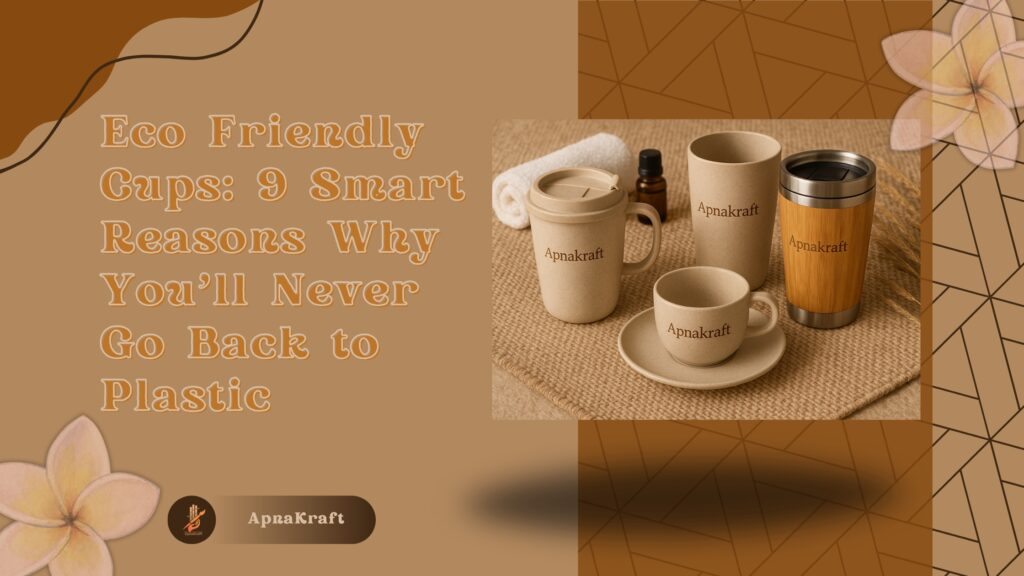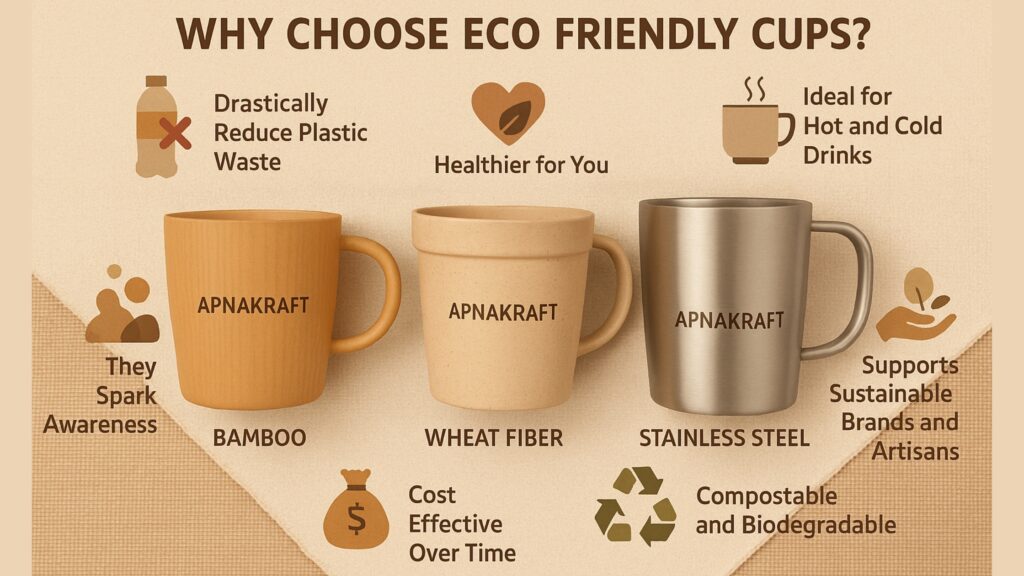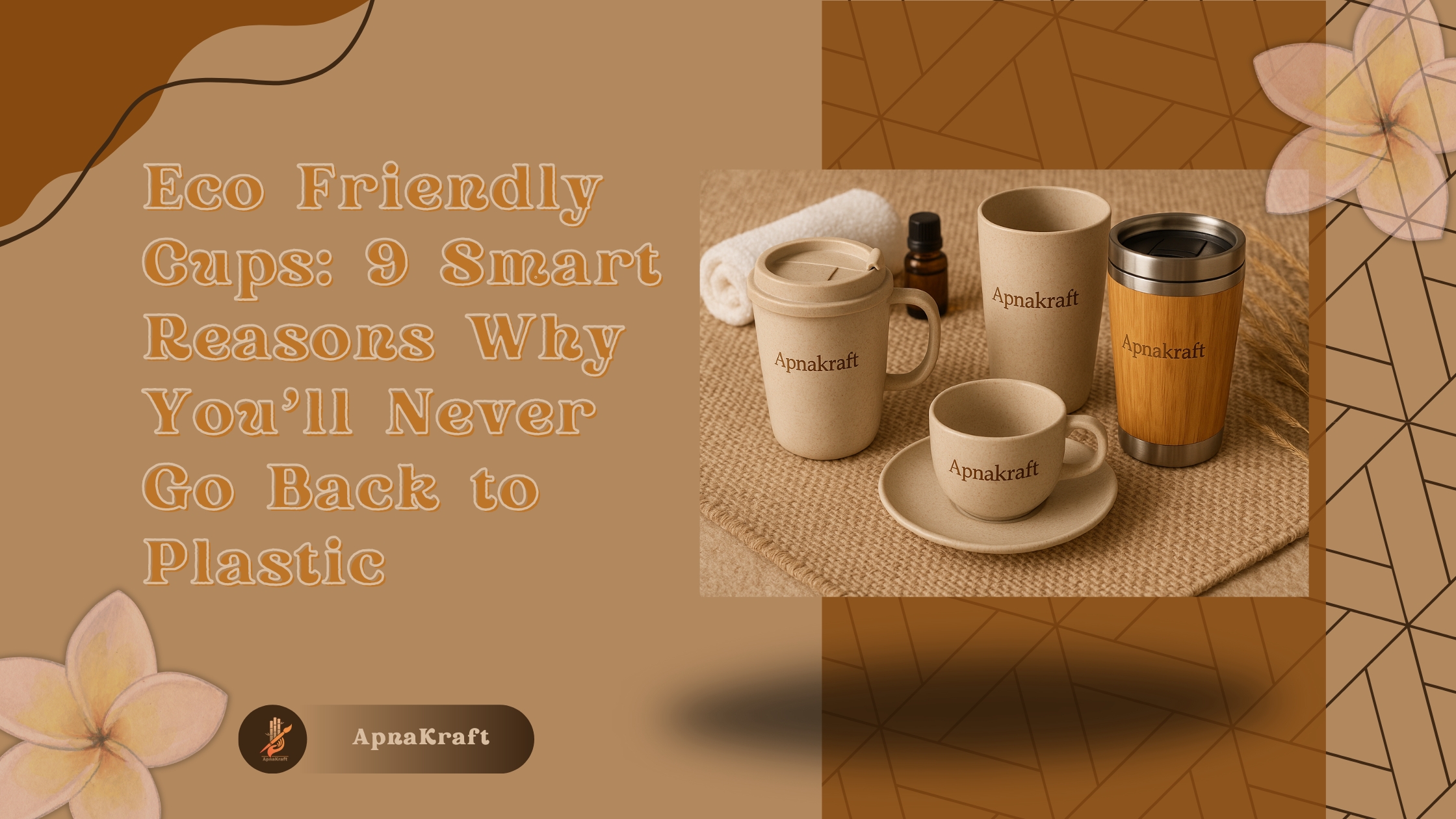If you’ve ever tossed a paper or plastic cup into the trash and felt a twinge of guilt—you’re not alone. With growing awareness about climate change and ocean pollution, more people are rethinking their everyday choices. One simple but powerful switch? Eco friendly cups.
These sustainable alternatives are more than just a trend—they’re a lifestyle shift. From reducing landfill waste to elevating your drink experience, eco friendly cups are a small change that creates a massive impact.

In this blog, we’ll explore why making the switch is smarter than you think, what types of eco cups are available, and how you can incorporate them into your daily routine effortlessly.
What Are Eco Friendly Cups?
Eco friendly cups are reusable or biodegradable alternatives to single-use plastic and styrofoam cups. They’re made using sustainable materials like bamboo, stainless steel, glass, PLA (plant-based plastic), wheat straw, and even coconut shells.
Key characteristics:
- Non-toxic and BPA-free
- Recyclable, compostable, or reusable
- Low carbon footprint in production and disposal
These cups are designed not just to reduce harm to the environment but to offer a safer, better drinking experience.
Why Choose Eco Friendly Cups? (Expert-Backed Reasons)
Switching to eco friendly cups benefits you and the planet. Here are the top 9 reasons, backed by data and real-world experience:
1. Drastically Reduce Plastic Waste
Each year, billions of plastic cups are thrown away globally. Most are never recycled. An eco friendly cup helps eliminate hundreds of disposable cups per person annually.
“My family switched to stainless steel cups two years ago. We haven’t bought a single pack of disposables since.” — Nikita G., Bangalore
2. Healthier for You
Plastic cups often contain BPA or phthalates, chemicals linked to hormone disruption. Eco alternatives like glass or bamboo are naturally non-toxic.
3. Stylish and Functional
Modern eco friendly cups aren’t just green—they’re sleek. From aesthetic travel mugs to artisanal coconut shell cups, they’re designed to impress.
4. Cost Effective Over Time
You might spend ₹300–₹600 on a good eco cup—but over time, it pays off. Fewer disposables, less waste, and more value.
| Type | Average Lifespan | Initial Cost | Cost Per Use (Est.) |
|---|---|---|---|
| Plastic Cup (Single Use) | 1 use | ₹2–₹5 | ₹2–₹5 |
| Bamboo Cup | 6–12 months | ₹300–₹500 | ₹0.80–₹1.30 |
| Stainless Steel Cup | 5+ years | ₹400–₹800 | <₹0.10 |
| Glass Tumbler | 2–3 years | ₹300–₹700 | ₹0.40–₹0.60 |
5. Supports Sustainable Brands and Artisans
Buying eco friendly cups often means supporting small businesses, fair trade cooperatives, or artisans working with sustainable materials.
“Each handmade coconut cup we sell supports a rural artisan in Kerala.” — ApnaKraft Product Team
6. Ideal for Hot and Cold Drinks
Unlike paper cups that get soggy or plastic that leaches toxins, eco cups retain temperature well—especially stainless steel and bamboo.
7. Compostable and Biodegradable Options
Cups made of PLA, rice husk, or wheat straw decompose naturally without harming soil or water.
8. Perfect for Gifting and Events
Looking for thoughtful return gifts or eco-conscious wedding favours? Customized eco cups are practical and unique.
9. They Spark Awareness
Using a reusable cup at a cafe or workplace often inspires others. It’s a silent but strong form of eco-activism.

Types of Eco Friendly Cups You Can Try
Here’s a quick overview of popular eco friendly cup types:
Bamboo Cups
Lightweight, compostable, and stylish. Ideal for everyday use.
Coconut Shell Cups
Handcrafted from discarded coconut shells. Unique and rustic.
Stainless Steel Cups
Durable, rust-resistant, perfect for travel or office use.
Wheat Straw or Rice Husk Cups
Biodegradable and light. Great for kids and picnics.
PLA (Plant-Based Plastic) Cups
Compostable and ideal for bulk orders at events.
How to Choose the Right Eco Friendly Cup
Here’s a quick guide to help you pick:
Consider Usage
- Daily commute: Opt for leak-proof stainless steel or bamboo mugs.
- Home use: Go for glass or ceramic for elegance.
- Kids: Use unbreakable wheat straw or silicone cups.
Check for Certifications
- Look for BPA-free, food-grade, or compostable labels.
Choose Local
- Support Indian eco brands or artisans who use locally sourced materials.
Real-Life Benefits: A Quick Case Study
Meet Priya, a freelance designer from Pune.
“I used to go through 5–6 paper cups a day at work. After switching to a glass tumbler, I not only reduced my trash but also noticed my coffee stayed hotter for longer. Plus, I stopped drinking microplastics without even realizing it.”
Eco Friendly Cups vs. Disposable Cups: A Quick Comparison
| Feature | Disposable Cups | Eco Friendly Cups |
|---|---|---|
| Reusability | No | Yes |
| Health Impact | BPA, toxins | Safe materials |
| Environmental Impact | High | Low |
| Cost Over Time | Expensive | Cost-saving |
| Aesthetic Appeal | Basic | Stylish |
Expert Tips to Use Eco Cups the Smart Way
- Always keep a spare in your car or bag.
- Choose dishwasher-safe options for convenience.
- Customize with your name or quotes to avoid mix-ups.
- Educate your family—kids love fun, reusable designs.
- For offices or cafes, buy in bulk and offer incentives.
FAQ: People Also Ask
1. Are eco friendly cups really better than paper cups?
Yes. Paper cups are usually lined with plastic and not recyclable. Eco friendly cups are reusable or compostable and generate less waste.
2. What materials are most eco friendly for cups?
Bamboo, stainless steel, coconut shells, PLA, and wheat straw are among the top eco-friendly materials.
3. Can I microwave eco friendly cups?
Not all types. Glass and ceramic are usually microwave-safe, but bamboo, coconut shell, and stainless steel are not.
4. How do I clean eco friendly cups?
Most are hand washable with mild soap. Stainless steel and glass cups can be put in the dishwasher.
5. Where can I buy eco friendly cups in India?
You can find them online through sustainable marketplaces or eco-conscious brands like ApnaKraft.
Related Insights
- Reusable vs. Disposable Cups: What’s the Real Impact
- Best Eco Friendly Gifts Under ₹500
- Why Bamboo is the Future of Sustainable Products
- How to Host a Zero-Waste Party
- Eco Friendly Kitchen Swaps You Can Start Today
Conclusion
Switching to eco friendly cups is one of the simplest yet most impactful choices you can make. Whether you’re sipping chai on your balcony or coffee during a Zoom meeting, your cup can be more than just a vessel—it can be a statement.
With stylish options, health benefits, and long-term savings, the move is a no-brainer. Ready to make your drink eco-chic?
Choose better. Choose sustainable. Choose eco friendly cups today.
Looking for the perfect start? Check out our Eco Mug made of Wheat Fibre and Steel — durable, elegant, and designed for conscious living.

